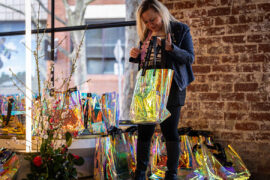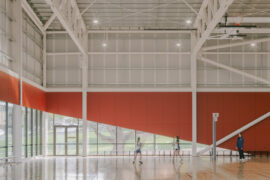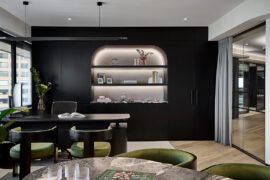The Jade Museum of Shanghai brings the elegance and playful design of Chinese calligraphy to architecture, courtesy of Archi Union.
Calligraphy can be seen as the art of giving form to signs in an expressive, harmonious, and expert manner, so the parallels to design are obvious. It’s with this in mind that Chinese architecture studio Archi Union designed the Jade Museum Shanghai – an exhibition space dedicated to honouring and displaying the rich history of Chinese jade.
Located in the pedestrian shopping district of Xintiandi in Shanghai, China, the museum is housed within an existing structure, which prompted the architects to seek a design solution that creates a space that departs from the aesthetic of the host building. The long-standing art of Chinese calligraphy became the driving aesthetic force for the interior mood and design of the space. Chinese calligraphy has a history as rich and detailed as that of jade – both are precious and feature extensively in the artistic and design history of the country, which meant for a natural partnership in aesthetics.
The sphere design was chosen to deliver this unified concept. A primal shape, that exists in nature symbolically, but the structurally efficient and perfect shape only exists in design. Internally, sinuous three-dimensional forms capture the flowing light and brush it along the surfaces before gradually fading into the space.
It was through advanced digital fabrication methods that allowed these calligraphy-reminiscent design flourishes to come to life. The assembly method recalls the geography of the earth too, as the walls are characterized by thin layers of material alluding to layers of rock.
The sequence of spheres throughout the space guides the movement of visitors through the exhibition halls, providing a series of spaces suitable for different exhibitions.
Words by Andrew McDonald
Photography by Hao Chen
INDESIGN is on instagram
Follow @indesignlive
A searchable and comprehensive guide for specifying leading products and their suppliers
Keep up to date with the latest and greatest from our industry BFF's!

The undeniable thread connecting Herman Miller and Knoll’s design legacies across the decades now finds its profound physical embodiment at MillerKnoll’s new Design Yard Archives.

Gaggenau’s understated appliance fuses a carefully calibrated aesthetic of deliberate subtraction with an intuitive dynamism of culinary fluidity, unveiling a delightfully unrestricted spectrum of high-performing creativity.

How can design empower the individual in a workplace transforming from a place to an activity? Here, Design Director Joel Sampson reveals how prioritising human needs – including agency, privacy, pause and connection – and leveraging responsive spatial solutions like the Herman Miller Bay Work Pod is key to crafting engaging and radically inclusive hybrid environments.

In a two-part series on the future of work, we explore what work will look like in the post-pandemic future – and how businesses can best prepare to embrace this dynamic transition.
We take a moment to chat with Kaye San Jose from Pure Creative Group
The internet never sleeps! Here's the stuff you might have missed

Explore the prizes up for grabs at Saturday Indesign this year when you register and check into 10+ showrooms on the day.

With the Evershield® Anodising 50-Year Warranty, AAF offers peace of mind that architectural aluminium will remain vibrant, resilient, and beautiful for generations.

Joan Montgomery Centre PLC by Warren and Mahoney is a tour de force of education design, with high-end facilities including a swimming pool and general athletic amenities.

Setting the tone for McCormack’s HQ is Elton Group’s Eveneer WoodWall and Eveneer Raw in Ravenna – wrapping walls, ceilings and bespoke joinery in a dark, matte elegance. The seamless pairing delivers a cohesive, high-performance finish that anchors Studio 103’s luxurious, hotel-inspired workplace design.